From the earliest days of electronic computers, people used them to make art: from drawings to poems, from screenplays to paintings, and from music to films. Our exhibit, “Early Computer Films, 1963-1972” presented breakthrough films in computer animation. Today, this technology is everywhere, from cinema to gaming, and from the web to art galleries. These films document advances in computer animation itself, and are artworks by some of the most important figures in computer art.
Explore the films below.
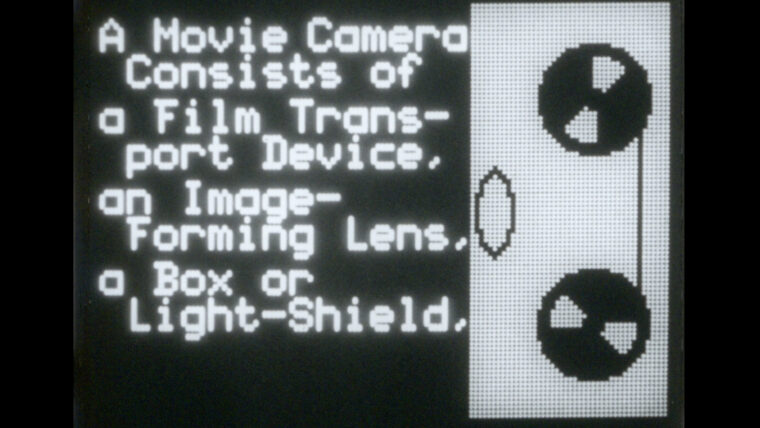
Silent, 2 min. excerpt of 16 min. original
Courtesy AT&T Archives and History Center
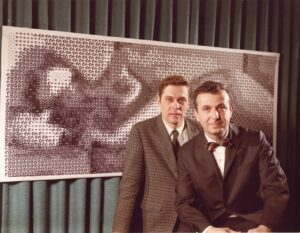
Born on his family’s farm in upstate New York, Ken Knowlton (b. 1931) would go on to have a profound role in the early development of computer animation, both as a tool for technical communication and as a tool for artistic expression. After earning a PhD in computing from MIT, Knowlton joined a computer research group at the Bell Telephone Laboratories in the early 1960s. He saw Edward Zajac’s 1963 computer-animated film of a satellite at the Labs and became extremely interested: “…that was exciting because…it was a new way to make animated movies that are technically accurate…expressing your intent in terms of computer programs.”
Knowlton developed a new computer language for making what he called “computer-produced movies,” animated films using the same IBM 7090 mainframe and SC-4020 microfilm plotter as had Zajac. Knowlton’s new language was called BEFLIX (for “Bell Flicks”) and allowed a programmer to describe shapes in a 252 by 184 array of dots, and their motions and transformations. In all, the language consisted of about 25 types of commands, with programs punched onto paper cards. One of the first films that Knowlton made using BEFLIX was a movie like Zajac’s, made for communicating new technical knowledge. In Knowlton’s case, the film was animation that explained in detail how he used BEFLIX to create animated films. In the second half of the 1960s and into the 1970s, Knowlton closely collaborated with the artists Stan VanDerBeek and Lillian Schwartz on their abstract animated films that incorporated computer animations.
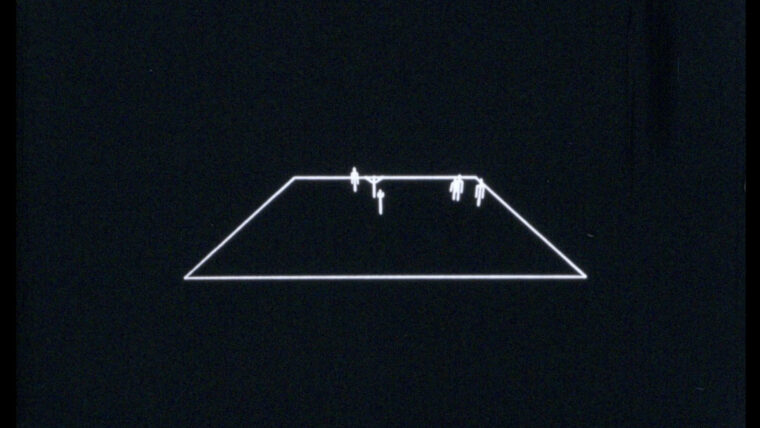
Silent original, soundtrack addition of Igor Stravinsky’s “Apollo”, 2:33 min.
Courtesy AT&T Archives and History Center
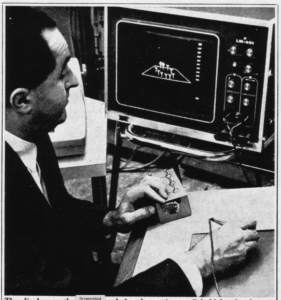
A. Michael Noll (b. 1939) worked as a Bell Telephone Laboratories researcher, and developed a wide-reaching vision for the possibilities of the digital computer for the arts, in the early 1960s. In 1962, during a research project to graph data concerning human speech, Noll saw the capabilities of the Labs’ IBM 7090 mainframe and SC-4020 microfilm plotter to generate visual imagery. He began generating 2D static abstract drawings, which were publicly shown in one of the first exhibitions of computer art, at the Howard Wise Gallery in New York City in 1965.
At this same time, Noll, who was a ballet fan, created a computer animated film of a system he had developed for computer-assisted choreography of dance. In it, a choreographer could interactively design a dance on screen, with both precisely programmed and randomized movements. The finished dance could be recorded as an animated film. Noll developed this animated film to “illustrate very crudely the type of visual display that might be shown to the choreographer.” The film was most commonly presented accompanied by Stravinsky’s “Apollo,” which motivated Noll in his project.
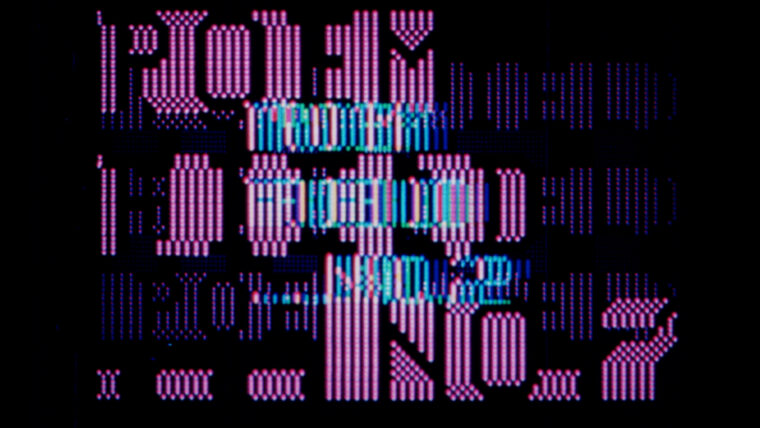
16mm film transferred to video, color, sound, 3 min. excerpt of 6:36 min. original
Music by Paul Motian, realized with Ken Knowlton
Courtesy of the Stan VanDerBeek Archive
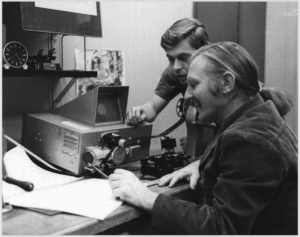
Stan VanDerBeek (1927-1984) was an American experimental filmmaker and multimedia artist. During the 1960s, VanDerBeek was a notable figure in New York’s avantgarde artworld. In the mid 1960s, he was developing his concept of the Movie-Dome, a domed structure as a site for an immersive experience and performance incorporating sound, communication technologies, and projections of various kinds. For part of this period, he was teaching film and animation at Columbia University. Through mutual friends, VanDerBeek was introduced to Ken Knowlton, a computer researcher at the Bell Telephone Laboratories nearby and the creator of the BEFLIX language for making computer-animated films.
In the spring of 1966, VanDerBeek visited Bell Labs and worked with Knowlton on the creation of a series of computer-animated films. These films built from VanDerBeek’s experience in the 1950s making hand-drawn and collage-based animations. His computer-animated series at Bell Labs is titled Poemfields, and center on the presentation of a series of words, and visual movement and manipulation of the text forms. The computer animations of Poemfields were made using BEFLIX on the Labs’ IBM 7090 mainframe and SC-4020 microfilm plotter. As such, the animations were first visible only when fully complete. VanDerBeek remarked, “To make computer films is like learning to draw by pushing a pencil around with your nose.”

Silent , 4 min. excerpt of 10:05 min. original
Courtesy of the ZKM Center for Art and Media and Caroline Csuri

Charles Csuri (1922-2022) was a pioneer of computer art who died in 2022, just months shy of his 100th birthday. Csuri was an accomplished college football player at Ohio State University, who was drafted into the NFL, but set aside this career for service in the US Army during the Second World War. After earning a Bronze Star for fighting in the Battle of the Bludge, Csuri returned to Ohio State where he earned a MA in art and joined the Department of Art’s faculty. Around 1963, Csuri saw a computer-produced woman’s portrait generated on a modified automatic typewriter produced by then-graduate student Juris Raudseps. Fascinated, Csuri began collaborations computing experts at the university to produce images with computers. By 1964, Csuri began creating 2D images, a practice that he continued to his death.
In 1967, Csuri created a computer-animated film, “Hummingbird.” The film was generated in much the same fashion as the computer animations from the Bell Telephone Laboratories. He used FORTRAN programs on the university’s IBM 7094 mainframe, and output the animations on a CalComp Model 835 microfilm plotter. “Hummingbird” begins with a digitized hand-drawn figure, the line elements of which subsequently undergo a variety of geometric movements and transformations.
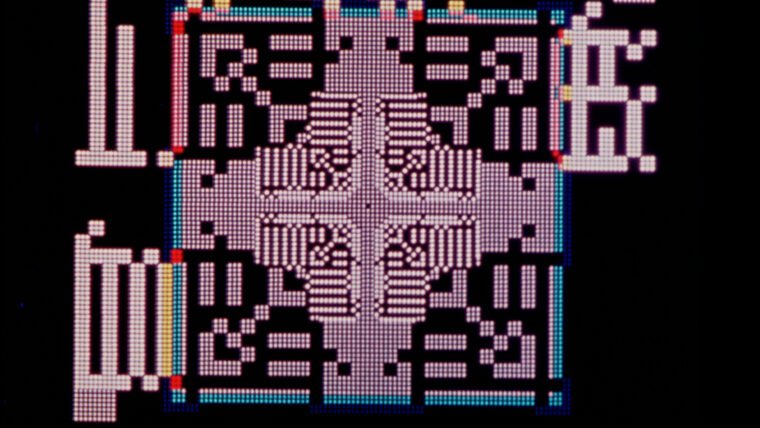
16mm film transferred to video, color, sound, 4:47 min.
Music by John Cage, realized with Ken Knowlton
Courtesy of the Stan VanDerBeek Archive
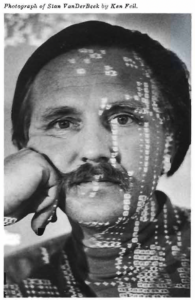
Like most of the artists who made abstract animations with computers in this early period, Stan VanDerBeek’s process for creating his computer-animated films was hybrid. In addition to generating black and white animations from microfilm plotters under programmed control, VanDerBeek subsequently processed, added to, and manipulated these film segments using traditional optical cinematic processes. These steps included adding colors and additional motions.
After his time at Bell Labs in 1966, VanDerBeek went to MIT’s Center for Advanced Visual Studies as an artist-in-residence. There he completed the final films in the Poemfields series, including “Poemfield, No. 7.” This film involved VanDerBeek’s collaboration with avantgarde composer John Cage. Cage provided the music for the film. The ending text that appears on screen, “No More War,” indelibly links the film to the artists’ concern with the Vietnam War.
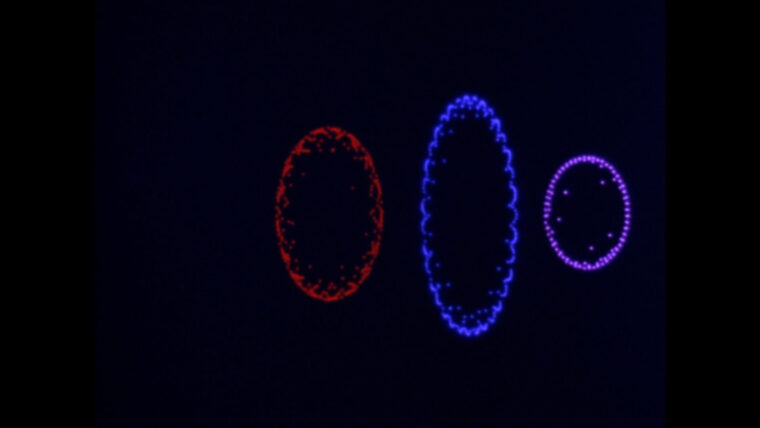
16mm film, (color, sound) transferred to high-definition digital video, 8 min.
Courtesy of Whitney Editions, LLC
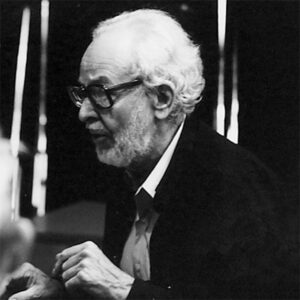
John Whitney Sr.
John H. Whitney, Sr. (1917-1995) was an American experimental filmmaker, composer, and a pioneer of computer animation. A southern California native, he began making abstract art films in the 1930s, often in collaboration with his brother James. In the late 1940s, Whitney was awarded a Guggenheim Fellowship, with which he explored and studied connections between music composition and graphics. Whitney began using surplus military analog computing machinery, electronic controls, and optical cinema tools to create animations with complex geometries and motions in the 1950s. In 1952, he created a firm, Motion Graphics Inc., in which he used this system to create visual effects and title sequences for the movie industry. In 1965, Whitney received a research grant from IBM, which then dominated the computer industry, to become an artist-in-residence and to explore the possibilities of using the digital computer for producing animated films.
Whitney collaborated with Jack P. Citron and other staff of the IBM Los Angeles Scientific Center to create a series of computer-animated films in the late 1960s. Unlike researchers and artists who had used microfilm plotters to create computer films, Whitney created his films by recording a computer display with a cinema camera. Whitney used programs created by Citron in a special programming language Citron had developed called GRAF, that extended the FORTRAN language for generating graphics on IBM’s advanced graphical display, the 2250. Each frame of the animation was generated by program control on the display, where it was captured by an automatically controlled cinema camera.
Whitney created a library of these computer animations that the then, like the other artists working with computer animation at the time, manipulated, transformed, and extended using traditional optical cinema techniques. In particular, Whitney used an optical printer – a combination of cinema camera and film projector – to add color, motions, and compound images to his final film.
Whitney’s 1968 film, “Permutations,” is a wonderful example of Whitney’s interest in “visual harmonics,” using computer animation to create a visual language of movement and transformation as evocative and expressive as music’s harnessing of auditory change. At the time he was working on “Permutations,” Whitney wrote: “The power of the computer to produce endless variations upon pattern, which stems from the basically mathematical foundation by which all images are formed, means that we have at hand an instrument for graphics that is analogous to the variational power of all musical instruments and the mathematical foundations of all musical form.”
4 min.
Music by Gershon Kingsley, computer animations realized with Ken Knowlton
Moving Image from the Collections of The Henry Ford
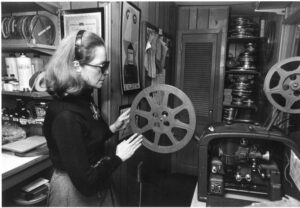
Lillian Schwartz (b. 1927) has spent her long life of artmaking exploring new mediums and pushing existing media. She really came into her own as an artist in the early 1960s, as she drew from the world of technology for new materials for creating new art. From sculptures made by physically and chemically altering acrylic, to kinetic sculptures incorporating electrical lighting and hydraulic flows, Schwartz became increasingly interested in the potentials for technology in artmaking. Her multimedia kinetic sculpture of 1968, “Proxima Centauri,” earned her a place at the groundbreaking MoMA exhibit, “The Machine as Seen at the End of the Mechanical Age” that year. That exhibit also brought her into conversation with Bell Labs researchers who were interested in, and pursuing, computer art.
This conversation led to an invitation for Lillian Schwartz to visit the Bell Telephone Laboratories, with which she would then become associated for the next three decades. Initially, she worked at the Labs as something of an artist in residence, eventually gaining a paid position in the group of Max Mathews, himself a central figure in the development of computer music. At Bell Labs in the early 1970s, Lillian Schwartz produced a remarkable series of experimental films incorporating computer animations. She worked with Ken Knowlton on the creation of the computer animations, which she subsequently altered dramatically, adding color and motion, and added to with a variety of footage, like hand painted sequences. Frequently, Lillian collaborated with computer musicians to score these films, both Bell Labs researchers and avantgarde composers who visited the Labs. Schwartz has focused on using the computer for artmaking to the present. He 1970 film “Pixillation” reveals her transformation of relatively limited computer animation capabilities into an extraordinarily expressive medium.
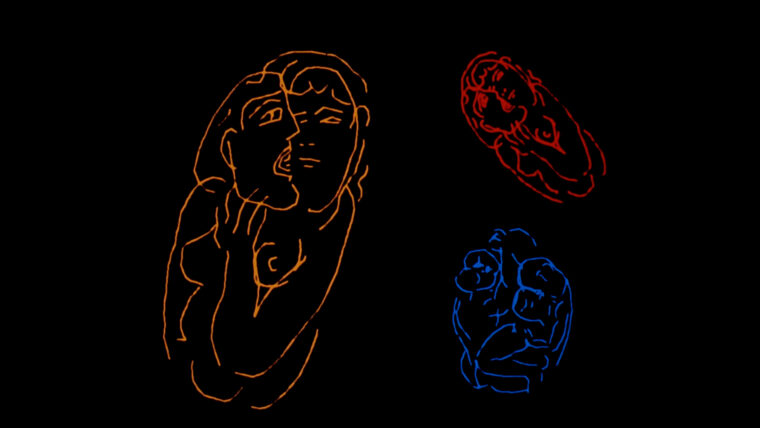
8:43 min.
Music by Alain Clavier, produced by Pierre Moretti
Computer animation realized with Nestor Burtnyk and Marceli Wein
Courtesy of the National Film Board of Canada
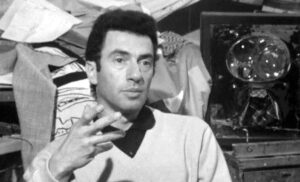
Peter Foldes (1924-1977) was born in Budapest, Hungary and moved to the United Kingdom in the 1940s. There he attended art school, and began his career as a painter. In the 1950s, he moved into experimental film, particularly animated films. He and his wife Joan created an experimental animated film in 1956 using painting techniques, “Short View,” that treats the danger of nuclear annihilation in the Cold War. Afterward, Foldes moved to Paris where he continued filmmaking and painting through the 1960s.
In the second half of the 1960s, Nestor Burtnyk, an electrical engineer, and Marceli Wein, a physicist, were working on interactive computer graphics at the National Research Council of Canada, and had begun experiments in computer animation. Burtnyk learned about Disney’s traditional animation technique of “inbetweening” or “key frame animation” at a 1969 meeting in Los Angeles, and thought it would be a good technique for computer animation. Key frames are drawings that define the beginning and the end states of an animated motion or action, with frames then added in between by assistant animators to create the smooth motion. Burtnyk and Wein thought the computer could act as this assistant animator.
The pair developed software for key frame animation in 1969, with the animations produced by filming an advanced graphical display, as in John Whitney’s technique. The key frames were drawn by the use of a computer mouse, built at the lab. The researchers had been closely following the work of Douglas Engelbart, who had recently invented the mouse. In early 1970, the pair initiated a project with the French Animation Section of Canada’s National Film Board, to create a film using their new system. They soon connected with Peter Foldes to make this first film, “Metadata.” Made without using a script in 1970, all of the key frames were drawn by Foldes using the computer mouse. The computer generated the “in-betweens,” and the film was released in 1971. Foldes would earn international acclaim for his expressive and socially critical computer films, while Burtnyk and Wein would earn an Oscar for their contributions to computer animation.
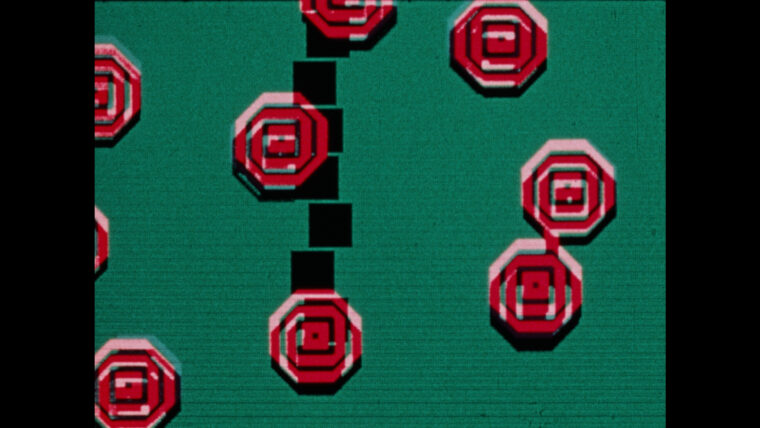
4:20 min.
Music by F. Richard Moore
From the Collection of the Computer History Museum. Courtesy The Henry Ford
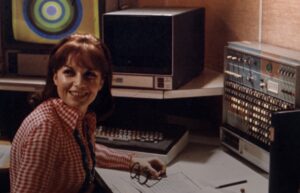
In the wake of the success of Lillian Schwartz’s 1970 film “Pixillation,” AT&T decided to commission the next film of her residency at the Bell Telephone Laboratories. Again supported by Ken Knowlton, using his new animation programming language EXPLOR, and again creating computer-animated sequences using the Labs’ SC-4020 microfilm plotter, Schwartz’s new film nevertheless marked a departure. She determined that she was “emotionally prepared to give up the hand-painted images [of “Pixillation”] and created this film entirely with computer images.” To add highly saturated color to the animated sequences, Schwartz used the optical printer of Bruce and Katherine Cornwell, experimental filmmakers who were using computer calculations to create animated films for mathematics education. Later, they too would create computer-animated films.
Schwartz’s 1972 film “Affinities” lies firmly within this creative line. In it, she uses only computer-generated animations made using EXPLOR, colorized later with highly saturated colors. Rhythmic motions and transformations of small circular elements play against a changing background of rectangular forms and lines. The visual motions are in a harmonious dialog with a score created by another Bell Labs resident, the composer and computer music trailblazer F. Richard Moore. Moore also worked in Max Mathews laboratory at Bell Labs, collaborating with him on his “MUSIC-N” family of computer music synthesis and composition software and also on GROOVE, Mathews software system for the live synthesis, composition, and performance of computer music. For his score for Lillian Schwartz’s “Affinities,” Moore used the Bell Labs computers to synthesize a version of Beethoven’s variation of Mozart’s instrumental piece “Là ci darem la Mano” from the opera Don Giovanni.
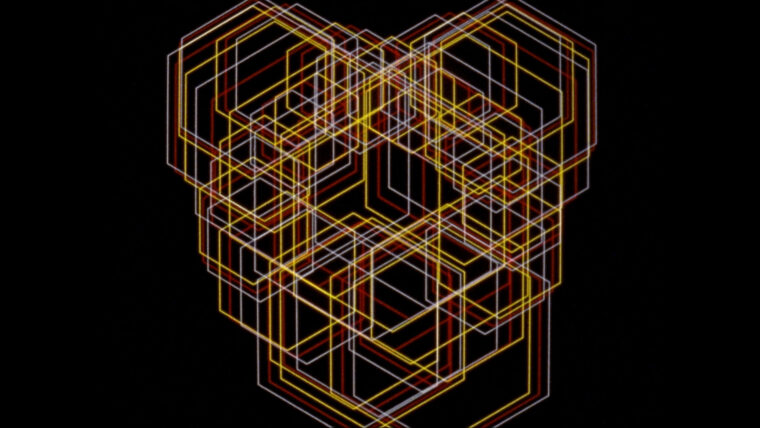
16mm film, (color, sound) transferred to high-definition digital video, 5 min. excerpt of 11 min. original
Score: Terry Riley, “Rainbow in Curved Air”
Courtesy of Whitney Editions, LLC
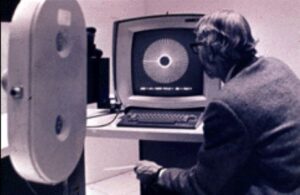
Following the success of his first computer-animated films, John Whitney moved away from a “batch” style of animation, in which a set of punched cards were created to program the animation and then executed in one go. In 1970, Whitney began making new films at the California Institute of Technology, Caltech, where we collaborated with Frederick Thompson who had recently joined the faculty, with appointments in both the humanities and engineering. Thompson, with linguist Bozena Dostert, had created a new, interactive programming language, REL, for “Rapidly Extensible Language.” In REL, programming took place in a much more “conversational” mode. Thompson and Dostert designed REL to be flexibly adapted for different kinds of problems, and created an “Animated Film Language” for it.
Whitney had access to Thompson and Dostert’s lab at Caltech through an IBM sponsored arts program. The REL Animated Film Language ran on an IBM System 360 computer and used the IBM 2250 graphical display, so Whitney could use his same approach to making computer-animated films as he had previously, filming the display and using an optical printer to add color and motion afterward. However, the programming of the animations was much different, typing instructions interactively into a teletypewriter and seeing the results executed on the display. Whitney’s “Matrix III” was competed in 1972. In it, triangles and squares swoop and transform across the screen. He explained “All motion is along a closed invisible pathway (the Matrix) which is a closed Lissajous figure positioned symmetrically within the motion picture film.” A Lissajous figure is a family of geometric curves that represent complex harmonic motions. Later, Whitney would observe that “…this power of the computer to liquify pattern, allowing complex pattern to flow with control, more than justified the difficulties of computer technology.”
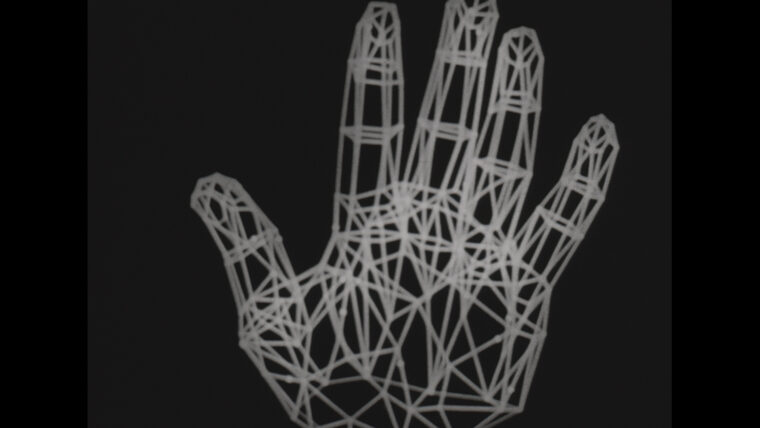
Silent, 4:43 min.
Courtesy Ed Catmull and Fred Parke
Collection of the Computer History Museum
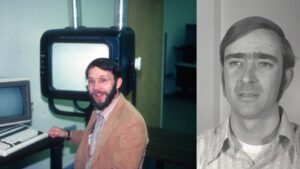
In the 1960s and the 1970s, the University of Utah was arguably the world’s leading center for computer graphics, including computer animation. The University’s strength in this area was due to its recruitment of Dave Evans and Ivan Sutherland—two computer graphics trailblazers—to the faculty, the porous boundaries between the University and the pair’s computer graphics start up, Evans and Sutherland, and the ability of the pair to get ARPA funding for their lab. In 1972, Ed Catmull and Fred Parke were graduate students working with Ivan Sutherland on computer animation. Their approach to the computer animation of 3D objects was a dramatic break from the past. Instead of animating line drawings that gave the illusion of 3D, Catmull and Parke were creating models of 3D objects as polygons arrayed in three dimensions, and then calculating a perspective view of them. Moreover, both used software to calculate a smooth, shaded surface covering their models. In this, Catmull and Parke’s animations opened an approach that would become the mainstream of computer animation to the present.
The film “Halftone Animation” was created by Catmull and Parke in 1972 to showcase the results of their 3D computer animation experiments. The film begins with a sequence showing Catmull’s 3D animation of his own left hand. It then moves to footage documenting how the 3D model was created, first by Catmull making a plaster cast of his hand and covering it with drawn polygons. The film then shows one of the ways in which these position of these polygons in three dimensions could be digitized into the computer. A sequence shows Catmull using a mechanical digitizer to map and record these positions using a movable arm and a foot pedal. However, Catmull found this mechanical digitizer too inaccurate, and digitized the plaster cast by viewing it through a grid at multiple angles, recording the observed positions, and “laboriously correcting the data.” This first part of “Halftone Animation” closes with footage of Catmull’s hand animated as a wireframe and then with its shaded surface applied. A middle part of “Halftone Animation” features footage of an artificial heart valve, digitized and animated by Catmull using the same techniques.
The closing section of “Halftone Animation” features Fred Parke’s animations of human faces. Here, Parke has modeled his wife’s face, by drawing polygons to cover her face, photographing it from multiple perspectives, and using these perspectives to digitize the shapes in three dimensions. Parke shows the resulting 3D model as a line drawing, with complex shading applied, and in multiple copies. In this “Halftone Animation” foreshadows an aesthetic of 3D computer graphics which would become ever more prominent in the decades ahead.
Early Computer Films, 1963-1972 was made possible by the members and supporters of the Computer History Museum.
We would also like to thank a wonderfully generous and helpful community of individuals and organizations who provided materials, permissions, and encouragement for the exhibit:
The AT&T Archives and History Center
Dr. Sheldon Hochheiser, AT&T Corporate Historian
A. Michael Noll
The StanVanDerBeek Archive
Chelsea Spengemann, Director of the Stan VanDerBeek Archive
ZKM Center for Art and Media
Margit Rosen, ZKM
Hartmut Joerg, ZKM
Caroline Csuri
Whitney Editions, LLC
John Whitney Jr.
The Henry Ford
Kristen Gallerneaux, Curator at The Henry Ford
The National Film Board of Canada
Jane Gutteridge, National Film Board of Canada
Ed Catmull
Fred Parke
Pixar Living Archives
Christine Freeman, Pixar
Chris Garcia
Dr. Zabet Patterson
Now Showing: Retro Games. Get Tickets
